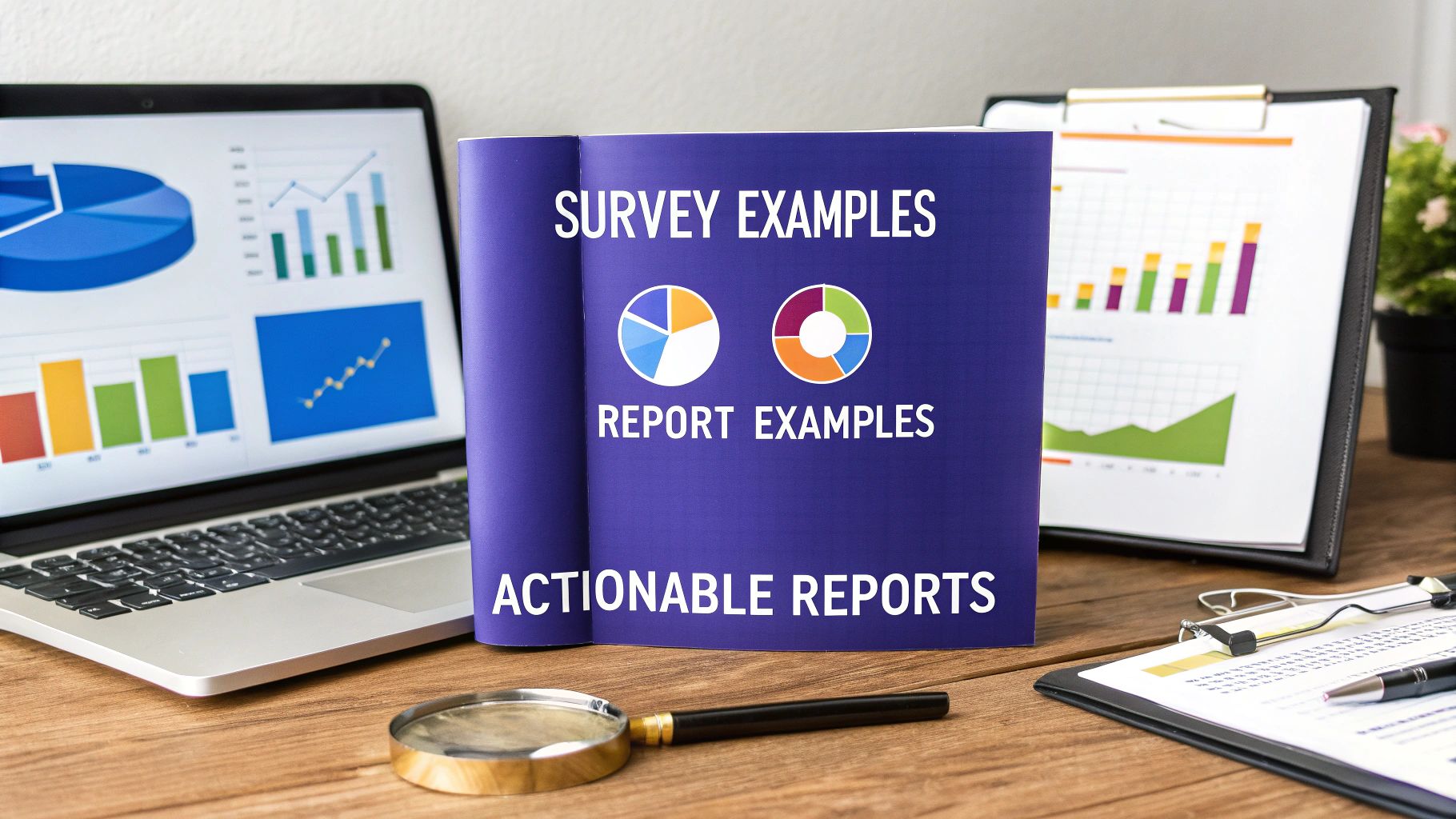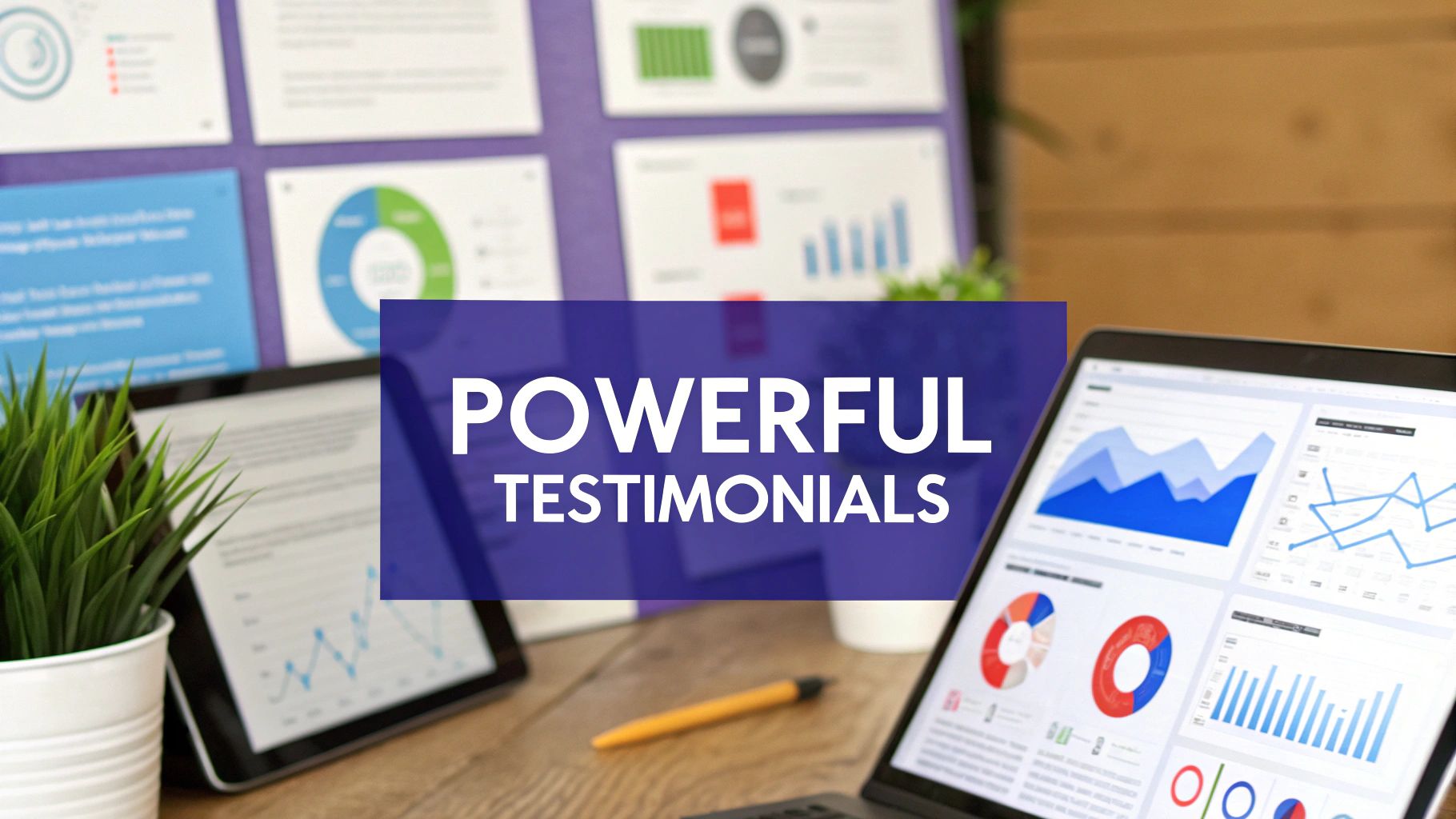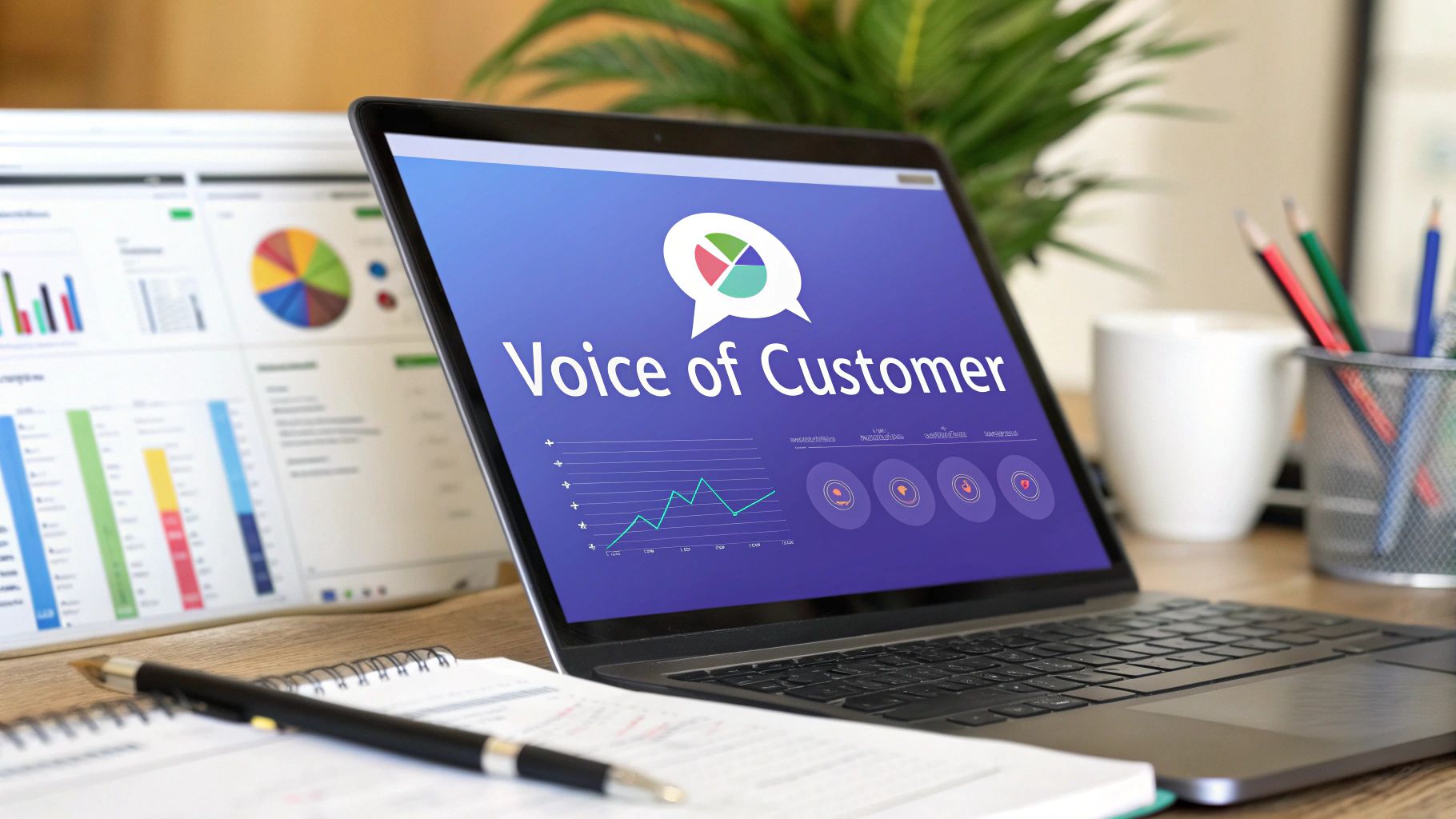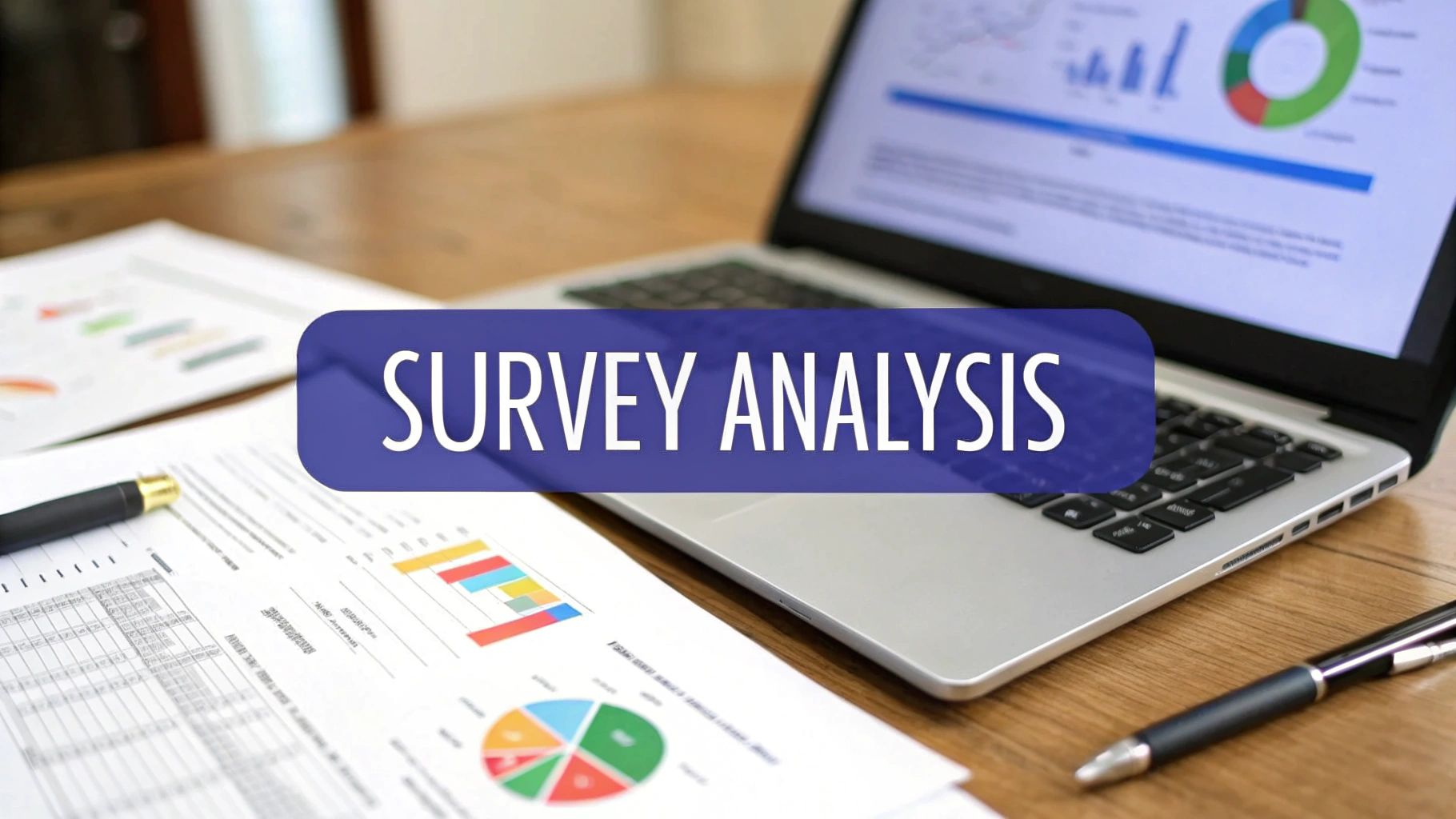8 Powerful Survey Report Examples to Inspire You in 2025
Discover 8 top survey report examples with breakdowns of their structure, insights, and key takeaways. Learn to create reports that drive real action.

Collecting survey data is one thing; presenting it effectively is another challenge. A well-crafted survey report turns raw numbers into a clear narrative, guiding your team to make informed decisions. Without a strong presentation, good insights from customer feedback or employee sentiment can get lost in spreadsheets, making your data collection pointless. This is why looking at high-quality survey report examples is so useful. It provides a blueprint for turning complex data into a simple, compelling story.
To turn raw survey data into clear, actionable reports, it's helpful to use robust platforms with detailed reporting capabilities. These tools help automate the visualization process, making it easier to spot trends and communicate findings. In this article, we will break down several different types of survey reports, from employee engagement to market research. For each example, we will analyze its structure, highlight key design choices, and extract actionable takeaways you can apply to your own reporting. You will learn how to structure your findings, visualize data clearly, and present insights that drive meaningful action. Let's get started.
1. Employee Engagement Survey Report
An Employee Engagement Survey Report is a useful tool for organizations to gauge workforce sentiment. It goes beyond simple satisfaction metrics to measure an employee's motivation, commitment, and emotional connection to their workplace. This type of report provides a structured analysis of how engaged employees are across different parts of the business, including leadership effectiveness, career growth opportunities, and company culture.
Tech giants like Google with its "Googlegeist" survey and Microsoft with its "Daily Pulse" show the power of this approach. They use the gathered data to drive meaningful changes, from refining management training to innovating workplace benefits. The primary goal is to turn feedback into a strategic asset for retaining top talent and boosting productivity. For a comprehensive report, it's important to apply effective frameworks for analysis. You can explore various methods for efficiently measuring team performance to structure your data interpretation.
Key Visualizations in Engagement Reports
To make the findings digestible, engagement reports often use clear data visualizations. The infographic below highlights three core components typically found in these summaries: the Employee Net Promoter Score (eNPS), a departmental performance heatmap, and year-over-year trend analysis.

This visual summary allows leadership to quickly identify overall loyalty with eNPS, spot specific departmental challenges on the heatmap, and see if initiatives are successfully moving the needle over time.
How to Implement and Act on the Findings
An effective engagement survey process is cyclical, not a one-off event. It involves careful planning, transparent communication, and a solid commitment to action.
- Anonymity is Key: Guarantee strict confidentiality to encourage candid feedback.
- Keep it Concise: Aim for 50 questions or fewer to maintain high completion rates.
- Mix Data Types: Combine quantitative scales (e.g., Likert scales) with open-ended questions for deeper qualitative insights.
- Share Results Promptly: Communicate key findings to the entire organization within a month of the survey closing to build trust.
- Create Action Plans: Develop specific, measurable, and time-bound action plans based on the report's recommendations.
2. Customer Satisfaction (CSAT) Survey Report
A Customer Satisfaction (CSAT) Survey Report is a basic tool for measuring how happy customers are with a company’s products, services, or specific interactions. These reports typically rely on simple, direct questions with a rating scale to capture in-the-moment feedback. This allows businesses to get a real-time pulse on the quality of the customer experience right after key touchpoints like a purchase or a support call.

Iconic brands like Amazon and Uber have integrated this feedback mechanism seamlessly into their user experience. Amazon prompts for a rating after a purchase, while Uber asks for a ride rating immediately after you arrive. The primary goal is to aggregate these satisfaction scores, quickly identify customer pain points, and connect satisfaction data to key business outcomes like loyalty and repeat purchases. For a deeper look at this metric, you can find strategies on how to improve customer satisfaction and make the data more actionable.
Key Metrics in CSAT Reports
To make CSAT findings clear and actionable, reports often focus on a few core metrics. These include the overall CSAT score (usually expressed as a percentage), a breakdown of responses by rating (e.g., satisfied, neutral, dissatisfied), and a qualitative analysis of open-ended feedback to uncover the "why" behind the scores. These elements help teams quickly grasp performance and pinpoint specific areas for improvement.
How to Implement and Act on the Findings
A successful CSAT program is about quick collection and even quicker action. It thrives on capturing feedback while the experience is still fresh in the customer's mind and then closing the loop effectively.
- Timeliness is Important: Send surveys within 24 hours of an interaction to maintain accurate recall.
- Keep it Short: Limit surveys to 3-5 questions to maximize completion rates and respect the customer's time.
- Ask 'Why': Always include an optional open-ended question after the rating to gather valuable qualitative context.
- Set Up Alerts: Create automated alerts for low scores to enable immediate follow-up from customer success or support teams.
- Close the Loop: Make it a policy to respond to dissatisfied customers promptly to resolve their issues and show you value their feedback.
3. Net Promoter Score (NPS) Survey Report
A Net Promoter Score (NPS) Survey Report is a direct tool for measuring customer loyalty with a single question: "On a scale of 0-10, how likely are you to recommend our company/product/service to a friend or colleague?" This report categorizes respondents into Promoters (score 9-10), Passives (7-8), and Detractors (0-6). The final score is calculated by subtracting the percentage of Detractors from the percentage of Promoters.
This simple metric provides a clear snapshot of overall customer sentiment and brand advocacy. Companies known for exceptional customer experience, like Apple (NPS of 72) and Tesla (NPS often exceeding 90), use this data to validate their market position and guide strategic decisions. The report's main purpose is to turn customer feedback into a predictive indicator of revenue growth and retention, making it one of the most important survey report examples for businesses focused on customer-centricity.
Key Visualizations in NPS Reports
To communicate findings effectively, NPS reports rely on straightforward visuals. A typical report will feature a prominent gauge or bar chart displaying the overall NPS score, a breakdown of Promoters, Passives, and Detractors, and a trend line showing how the score has changed over time.
This visual approach allows stakeholders to instantly grasp the current state of customer loyalty, see the composition of their customer base, and track the impact of their initiatives on customer sentiment.
How to Implement and Act on the Findings
A successful NPS program is about continuous improvement, not just measurement. It requires a systematic approach to collecting feedback and, more importantly, acting on it.
- Follow Up with an Open-Ended Question: Always ask "What is the primary reason for your score?" to uncover the "why" behind the number.
- Close the Loop Quickly: Contact Detractors within 24-48 hours to address their concerns and show you value their feedback. This can often turn a negative experience into a positive one.
- Segment Your Data: Analyze NPS by customer lifecycle stage, product line, or region to identify specific pain points and opportunities.
- Activate Your Promoters: Encourage your most loyal customers to write reviews, participate in case studies, or join referral programs.
- Track Trends Over Time: Administer NPS surveys on a regular schedule (e.g., quarterly) to monitor progress and correlate changes with business initiatives.
4. Market Research Survey Report
A Market Research Survey Report provides a thorough analysis of market dynamics, consumer behavior, and competitive landscapes. Businesses use these reports to gather actionable intelligence that informs strategic decisions. This type of report synthesizes quantitative data like market size and demographic trends with qualitative insights into customer preferences and brand perception.

Leading research firms like Nielsen, Gartner, and the Pew Research Center have perfected this approach. Their reports, such as Nielsen's Consumer Confidence Index or Gartner's Magic Quadrant, are industry benchmarks that guide investment, product development, and market-entry strategies. The main goal is to minimize risk and identify growth opportunities by knowing the market environment with precision.
Key Visualizations in Market Research Reports
To convey complex market data effectively, these reports rely heavily on visualizations. Three common components are market segmentation charts, competitive analysis matrices, and consumer journey maps. Market segmentation charts, often pie or bar graphs, show the demographic or psychographic breakdown of the target audience.
A competitive matrix plots competitors based on key attributes like price and quality, revealing market gaps. Consumer journey maps visually trace customer interactions across multiple touchpoints, highlighting pain points and opportunities. These visuals help stakeholders quickly absorb findings and align on strategic priorities.
How to Implement and Act on the Findings
A successful market research project delivers clear, actionable insights. The process requires meticulous planning, precise execution, and a commitment to applying the results to business strategy.
- Define Clear Objectives: Start by outlining exactly what you need to learn. Are you testing a new product concept, evaluating brand awareness, or sizing a potential market?
- Use Proper Sampling: Employ probability sampling methods to get results that are representative of the broader target population.
- Pilot Test Your Survey: Before a full launch, test the survey with a smaller group (50-100 respondents) to identify confusing questions or technical glitches.
- Screen for Qualified Respondents: Use initial screening questions to filter out participants who do not fit your target demographic or criteria.
- Create Actionable Roadmaps: Translate the key findings from the report into specific initiatives for marketing, product, and sales teams.
5. Academic Research Survey Report
An Academic Research Survey Report is a highly structured document detailing survey-based research that adheres to rigorous scholarly standards. These reports are foundational to advancing knowledge in various fields, requiring strict protocols for sample selection, data collection, and statistical analysis. The main purpose is to produce findings that are valid, reliable, and contribute to the existing body of academic literature.
Renowned institutions like the University of Michigan with its Panel Study of Income Dynamics or the Pew Research Center showcase this report's power. Their work provides longitudinal data and insights that inform public policy, economic theory, and social sciences. These survey report examples show a commitment to methodological precision and transparent reporting, making their findings a cornerstone for further research and societal understanding.
Key Visualizations in Academic Reports
To communicate complex findings, academic reports use precise visualizations. Common visuals include statistical tables showing regression analysis, charts displaying demographic distributions, and graphs illustrating correlations between variables. The goal is to present data in a way that supports the research hypotheses and allows for peer scrutiny. These visuals are less about aesthetic appeal and more about analytical clarity and accuracy.
How to Implement and Act on the Findings
Conducting academic research and compiling the report is a meticulous process governed by established conventions. It requires a systematic approach from conception to publication.
- Secure Ethical Approval: Always obtain Institutional Review Board (IRB) approval before starting any data collection involving human subjects.
- Use Validated Instruments: Whenever possible, use pre-existing, validated scales from published research to maintain measurement reliability.
- Plan Your Sample Size: Conduct a power analysis to calculate the minimum sample size needed to detect a statistically significant effect.
- Report All Findings: Disclose both statistically significant and non-significant results to provide a balanced view and prevent publication bias.
- Leverage Open-Ended Questions: For deeper contextual information, you can learn how to formulate effective open-ended research questions to complement quantitative data.
- Adhere to Style Guides: Follow the specific formatting requirements of a style guide like APA or Chicago precisely for citations, tables, and manuscript structure.
6. Employee Exit Survey Report
An Employee Exit Survey Report synthesizes feedback from departing employees to uncover organizational challenges and opportunities for improvement. This report analyzes data on why people leave, their experiences, and what could have been done differently to retain them. It provides a structured look at turnover trends, helping to pinpoint issues within specific departments, management practices, or company-wide policies that affect retention.
Companies like LinkedIn have used exit survey insights to revamp their parental leave policies, directly addressing a key reason for departure. Similarly, Google's "Project Oxygen" used exit data to identify the traits of effective managers, which then informed a complete overhaul of their management training. The primary goal is to turn the departure of one employee into a valuable lesson that helps retain many others, ultimately strengthening the organization and its employer brand. You can find a comprehensive employee exit survey example to guide your own data collection and analysis.
Key Visualizations in Exit Reports
To clearly communicate findings, exit survey reports rely on targeted visualizations. Common visuals include a breakdown of turnover reasons by category, a comparison of regrettable vs. non-regrettable turnover, and trend lines showing turnover rates by department or tenure. These graphics help leaders quickly grasp the main drivers of attrition.
A visual summary allows leadership to see if turnover is primarily driven by compensation, management, or career growth. It also helps them focus retention efforts on high-performing employees who are leaving for preventable reasons.
How to Implement and Act on the Findings
A successful exit survey strategy is a continuous process that feeds directly into retention initiatives. It requires a systematic approach to collecting, analyzing, and acting on the feedback.
- Timing is Important: Conduct surveys after an employee resigns but before their last day to capture fresh, honest perspectives.
- Offer Multiple Formats: Use a combination of anonymous online surveys for quantitative data and confidential one-on-one exit interviews for qualitative depth.
- Ask Beyond the "Why": Inquire about the entire employee lifecycle, from onboarding to daily work experiences, to get a holistic view.
- Track Regrettable Turnover: Differentiate between the departure of high-performers and low-performers to prioritize action plans effectively.
- Share Findings Quarterly: Present aggregated, anonymized data to leadership regularly to keep retention on the strategic agenda and drive accountability.
7. Event Feedback Survey Report
An Event Feedback Survey Report is a key tool for organizers to measure the success of conferences, webinars, and other gatherings. It goes beyond simple attendance numbers to capture attendee satisfaction, engagement levels, and the overall experience. This report provides a structured analysis of important event components like content quality, speaker effectiveness, venue logistics, and networking opportunities.
Major events like SXSW and Salesforce’s Dreamforce use this feedback to shape future programming and innovate their event formats. For instance, session ratings directly influence which topics and speakers are invited back, making sure content remains relevant and high-quality. The main goal is to turn attendee feedback into a strategic asset for improving future events, showing ROI to stakeholders, and building stronger community relationships.
Key Metrics in Event Feedback Reports
To make the findings easy to understand, event feedback reports visualize key performance indicators. Common metrics include the Net Promoter Score (NPS) to gauge overall loyalty, session-specific satisfaction ratings, and logistical feedback on aspects like registration and venue. This data helps organizers pinpoint strengths and weaknesses with precision.
These visualizations allow event managers to quickly assess attendee sentiment, identify the most and least popular sessions, and see logistical bottlenecks that impacted the experience. This helps prioritize improvements for the next event cycle.
How to Implement and Act on the Findings
A successful event feedback strategy is a cycle of listening, analyzing, and improving. It requires timely execution and a clear commitment to acting on the insights gathered from your survey report examples.
- Send Surveys Promptly: Distribute the main feedback survey within 24 to 48 hours after the event concludes to maximize response rates while the experience is still fresh.
- Keep it Short: Limit surveys to 10 questions or less to respect attendees' time and increase the likelihood of completion.
- Incentivize Participation: Encourage responses by offering a prize drawing, exclusive content, or an early-bird discount for the next event.
- Segment Your Analysis: Break down data by attendee type, such as first-timers, VIPs, sponsors, or virtual participants, to uncover more specific insights.
- Share Key Findings: Distribute a summary of the results to attendees, speakers, and sponsors to show their feedback is valued and to maintain strong relationships.
8. Product Feedback Survey Report
A Product Feedback Survey Report is a strategic tool for analyzing user feedback on features, usability, and overall satisfaction. It guides the product development roadmap by turning user opinions into actionable data. This report combines quantitative metrics like feature usage and satisfaction scores with qualitative insights such as user pain points and feature requests to help teams prioritize improvements and validate new ideas.
Companies like Slack, Spotify, and Notion are excellent examples of this process in action. Slack used feedback loops to develop threaded conversations, while Spotify continuously refines its discovery algorithms based on user research. The goal is to make informed decisions about feature development, pricing, and market positioning. To do this effectively, you need a structured way to analyze the data, which can be supported by various product management frameworks that help organize and prioritize feedback.
Key Components in Product Feedback Reports
To make product feedback digestible, reports often focus on specific metrics that reveal user sentiment and priorities. Common visualizations include a feature satisfaction matrix, a summary of top feature requests, and an analysis of the Sean Ellis Test, which measures product-market fit by asking users how disappointed they would be if the product no longer existed. This combination helps product teams identify high-impact areas for improvement.
These visual components allow stakeholders to quickly see which features are performing well versus which ones are causing friction. They also provide a clear, data-backed list of what users want most, removing guesswork from the product roadmap.
How to Implement and Act on the Findings
An effective product feedback process is continuous and integrated into the product lifecycle. It requires careful planning, targeted questions, and a commitment to closing the feedback loop with users.
- Survey at Key Lifecycle Stages: Collect feedback during onboarding, after feature adoption, and at maturity to get a complete view of the user journey.
- Use In-App Surveys: Implement contextual, in-app surveys at strategic moments, like after a user completes a key workflow, to gather immediate and relevant feedback.
- Weight Feedback by Customer Value: Prioritize feedback from high-value customers (based on ARR or strategic importance) to align product development with business goals.
- Combine with Behavioral Data: Cross-reference survey responses with behavioral analytics (e.g., feature usage, click patterns) for a more complete picture of user experience.
- Close the Feedback Loop: Communicate back to users about which features were built based on their input to show their voice is heard and valued.
Comparison of 8 Survey Report Types
Putting These Examples into Practice
The survey report examples we've explored, from employee engagement to product feedback, share a common thread. They all show how to turn raw data into a compelling story that drives action. A great report interprets numbers, provides context, and lays out a clear path forward for your team.
The most effective reports make complex information accessible. They use strong visual elements like charts and graphs to highlight key trends instantly. They also begin with a concise executive summary that gives busy stakeholders the most critical information upfront. This structure respects the reader's time while still providing the depth needed for informed decision making.
Key Takeaways for Building Your Own Reports
As you prepare to create your own survey reports, keep these core principles in mind. They are the difference between a report that gets filed away and one that becomes a catalyst for change.
- Start with a clear objective. Before you write the first word, know what you want the report to achieve. Are you trying to justify a budget increase, guide product development, or improve team morale? Your goal will shape every part of the document.
- Prioritize visual storytelling. Humans process images far faster than text. Use bar charts for comparisons, pie charts for proportions, and line graphs to show trends over time. Make your data easy to understand at a glance.
- Focus on actionable recommendations. This is arguably the most important part of your report. Don't just state what the data says. Explain what it means and provide specific, concrete steps the organization should take next. Each recommendation should be a clear directive.
- Know your audience. Adjust the language, detail, and format to who will be reading it. An executive board needs a high-level overview, while a product team needs granular data. One size does not fit all.
From Data Collection to Strategic Action
Mastering the art of the survey report is a powerful skill for any team, especially in the fast-paced SaaS world. These documents are more than just summaries of feedback; they are strategic tools. They help you understand your customers, engage your employees, and find your competitive edge in the market.
By applying the techniques seen in these survey report examples, you can make sure your hard-earned data leads to meaningful improvements. You move beyond simple data collection into data-driven strategy. This shift helps you reduce churn, build a better product, and create a more responsive organization. The ultimate goal is to create a continuous feedback loop where insights consistently fuel better business outcomes.
Ready to turn customer feedback into actionable reports without the manual effort? Surva.ai automates the process of collecting and analyzing insights from product feedback, cancellation reasons, and satisfaction surveys. Create professional, data-rich reports that help you reduce churn and build a product your customers love.


